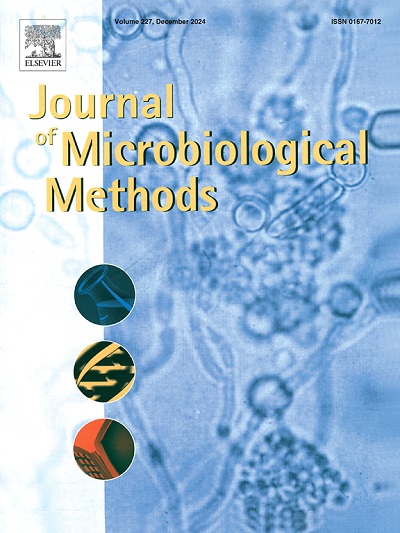Evaluation of a high-throughput method for processing sponge-stick samples to detect viable, non-spore-forming biothreat agents
IF 1.9
4区 生物学
Q4 BIOCHEMICAL RESEARCH METHODS
引用次数: 0
Abstract
After a bioterrorism incident, surface sampling is often used to determine the extent of contamination and exposure, guiding decontamination efforts and decisions for re-occupancy of affected sites. The sponge-stick (SS) is a preferred and commonly used device for sample collection to detect both spore-forming and non-spore-forming biothreat agents from non-porous surfaces. Here, a recently developed high-throughput method (HTM) for processing SS samples to detect viable Bacillus anthracis spores was adapted for detection of non-spore-forming biothreat agents, Yersinia pestis and Francisella tularensis. The scalable HTM was used to process up to 20 SS samples simultaneously, compared to the current stomacher-based method which processes one SS at a time. Comparisons of the HTM and the stomacher-based method were statistically indistinguishable for most experiments (P > 0.05) with HTM recoveries of 37–60 % for Y. pestis inoculated at 102–103 cells/SS and held 48 h at 4 °C to mimic sample transport/storage. The HTM was integrated with Rapid Viability-Polymerase Chain Reaction (RV-PCR) analysis to detect viable Y. pestis in the presence of particulate contamination (Arizona Test Dust, ATD). This approach detected Y. pestis inoculated at 20 cells/SS and ATD did not impact detection (P > 0.05). F. tularensis showed significantly lower recoveries between no-hold time and 48-h hold time (4 °C, P < 0.05) using the HTM, which further testing showed could be due to toxicity of the neutralizing buffer used for SS pre-wetting. With modifications, this method could enhance throughput capacity while maintaining similar recovery efficiencies to current methods for other non-spore-forming bacterial pathogens.
一种处理海绵棒样品的高通量方法的评估,以检测活的,非孢子形成的生物威胁剂。
在生物恐怖事件发生后,通常使用表面采样来确定污染和暴露的程度,指导去污染工作和重新占用受影响地点的决定。海绵棒(SS)是一种优选和常用的样品收集设备,用于从非多孔表面检测形成孢子和不形成孢子的生物威胁剂。在这里,最近开发的一种高通量方法(HTM)用于处理SS样品以检测活的炭疽芽孢杆菌孢子,适用于检测非孢子形成的生物威胁剂,鼠疫耶尔森氏菌和土拉弗朗西斯菌。可扩展的HTM被用来同时处理多达20个SS样本,而目前基于胃的方法一次处理一个SS。在大多数实验中,HTM方法与胃法的比较在统计学上没有区别(P > 0.05),接种10((Brisson et al., 2025)2)-103个细胞/SS,在4 °C下保持48 h以模拟样品运输/储存,鼠疫杆菌的HTM回收率为37-60 %。HTM与快速存活-聚合酶链反应(RV-PCR)分析相结合,检测存在颗粒污染的鼠疫杆菌(亚利桑那试验尘埃,ATD)。该方法检测接种20个细胞/SS的鼠疫菌,ATD对检测无影响(P > 0.05)。F. tularensis在不保温时间和48 h保温时间之间的回收率显著降低(4 °C, P
本文章由计算机程序翻译,如有差异,请以英文原文为准。
求助全文
约1分钟内获得全文
求助全文
来源期刊

Journal of microbiological methods
生物-生化研究方法
CiteScore
4.30
自引率
4.50%
发文量
151
审稿时长
29 days
期刊介绍:
The Journal of Microbiological Methods publishes scholarly and original articles, notes and review articles. These articles must include novel and/or state-of-the-art methods, or significant improvements to existing methods. Novel and innovative applications of current methods that are validated and useful will also be published. JMM strives for scholarship, innovation and excellence. This demands scientific rigour, the best available methods and technologies, correctly replicated experiments/tests, the inclusion of proper controls, calibrations, and the correct statistical analysis. The presentation of the data must support the interpretation of the method/approach.
All aspects of microbiology are covered, except virology. These include agricultural microbiology, applied and environmental microbiology, bioassays, bioinformatics, biotechnology, biochemical microbiology, clinical microbiology, diagnostics, food monitoring and quality control microbiology, microbial genetics and genomics, geomicrobiology, microbiome methods regardless of habitat, high through-put sequencing methods and analysis, microbial pathogenesis and host responses, metabolomics, metagenomics, metaproteomics, microbial ecology and diversity, microbial physiology, microbial ultra-structure, microscopic and imaging methods, molecular microbiology, mycology, novel mathematical microbiology and modelling, parasitology, plant-microbe interactions, protein markers/profiles, proteomics, pyrosequencing, public health microbiology, radioisotopes applied to microbiology, robotics applied to microbiological methods,rumen microbiology, microbiological methods for space missions and extreme environments, sampling methods and samplers, soil and sediment microbiology, transcriptomics, veterinary microbiology, sero-diagnostics and typing/identification.
 求助内容:
求助内容: 应助结果提醒方式:
应助结果提醒方式:


